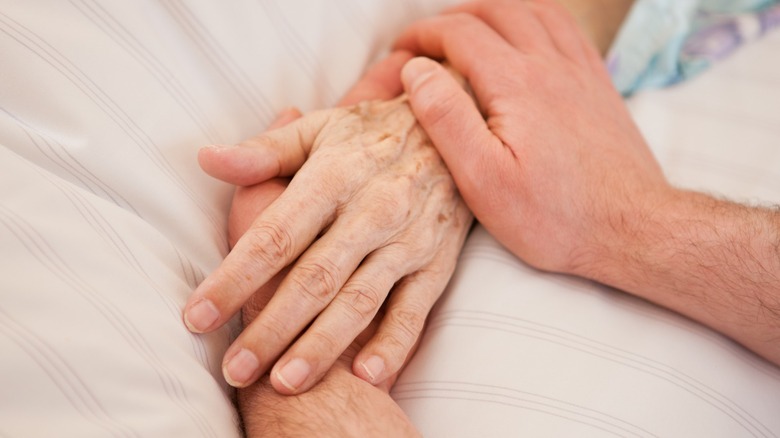End-Of-Life Researcher Explains The Death Rattle
Life is beautiful and can feel all too short-lived. Everyone lives a unique life and acquires their own experiences. However, all living beings have one thing in common: death. Death can be scary, but it is an inevitability and is part of the natural life cycle. Death might be sad, tragic, and fear-inducing, but it is still natural. You might wonder what the process of death is like, and in particular what causes the so-called "death rattle," the distinctive rattling breaths someone may take as they near the end of their life. In an exclusive interview, Health Digest spoke with Christopher Kerr, MD, PhD, Chief Medical Officer and Chief Executive Officer at Hospice & Palliative Care Buffalo to learn more. Dr. Kerr is also an end-of-life researcher and author of the book "Death Is But a Dream."
Dr. Kerr notes that the death rattle is a normal part of the dying process that affects about 45% of patients. "The death rattle emerges as consciousness diminishes and the patient is often no longer able to swallow, cough, or clear saliva or mucus at the back of the throat," says Dr. Kerr. "The sound made is variable, often crackling, gurgling, or wet-sounding, and is amplified by air passage as the patient breathes. Breathing patterns change as someone nears death and breath sounds may alternate from very quiet to loud."
How long does a person live after the death rattle starts?
According to Dr. Kerr, the death rattle can start a few hours or even a few days before death, however the average person dies approximately 25 hours after the onset. "Although there is no evidence that the dying person experiences pain or discomfort from a death rattle, studies have shown that most relatives find this symptom very stressful," says Dr. Kerr.
Dr. Kerr also gives some advice on the do's and don'ts for when a person or patient is experiencing a death rattle. "When faced with a patient experiencing a death rattle, caregivers can attempt to lessen the symptom burden by repositioning the patient on their side, providing oral care, or elevating the head of the bed so secretions can drain," says Dr. Kerr. "Medications may also be administered if prescribed by the patient's care team. Caregiver presence is always of comfort, [as well as] reassuring others that there is no evidence that the death rattle is painful or distressing to the patient."
It's important to remember that you should not try to give food or drink to someone with a death rattle, according to Dr. Kerr, because the patient can no longer swallow.


